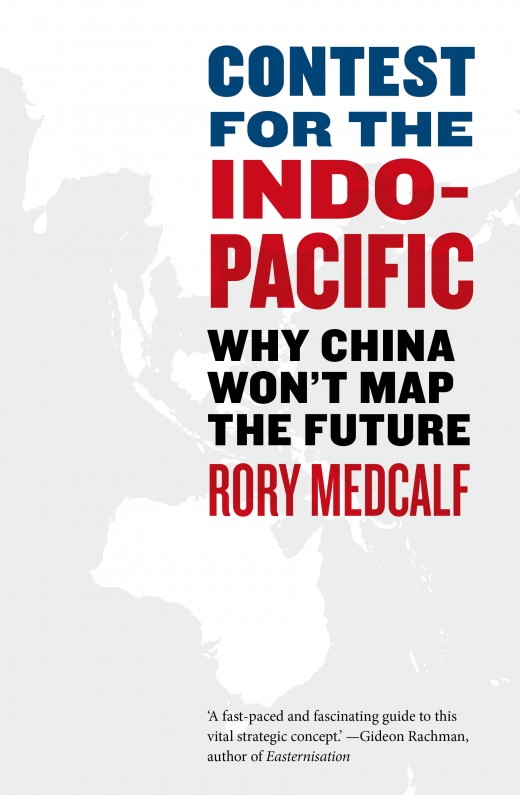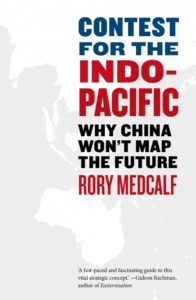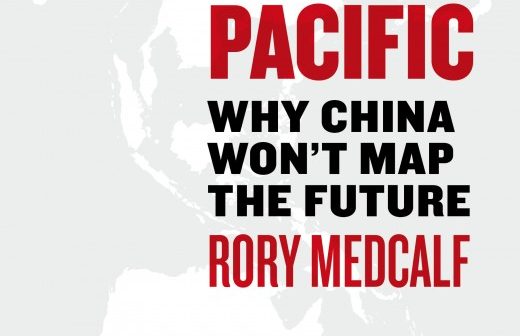

Contest for the Indo-Pacific: Why China Won’t Map the Future: Published by LaTrobe University Press in conjunction with Blank Inc. – ISBN 9781760641573
“China and the United States have entered a state of comprehensive struggle, amounting to full-spectrum rivalry. The Pentagon publicly labelled China a strategic competitor, and a series of blunt speeches in 2018 and 2019 by US vice president Mike Pence confirmed that this assessment has permeated America’s China Policy. The situation could deteriorate through miscalculation or confrontation.” (Contest for the Indo-Pacific, Why China won’t map the future, p. 20)
At the start of 2020, the world was amidst an industrial technology revolution and major power contestation, dealing with significant and rapid change – including to the global climate. The situation has since been exacerbated by a global pandemic, destabilising the world economy. The circumstance is that the deadly novel coronavirus originated in Wuhan, China. There are serious questions over China’s governance and transparency in how the virus was identified and managed. In this context, this book has a sharp, indeed, pinpoint focus.
Released at such a unique and ‘unprecedented’ time in modern human history, Medcalf makes more than mere mention of ‘black elephant’ events which may arise. COVID-19 is one such black elephant – “a likely event – and a bad one – that everyone sees looming yet still comes as a shock.”
Medcalf uses descriptors of China with reference to its; ‘perilous momentum’, ‘global power ambitions’; and being ‘excessive and coercive.’ Hence, Medcalf’s historical context across the opening three chapters is critical to setting the scene of today. In addressing the present geo-political theatre, captured in Chapters 5 – 8, at the time of his writing, the present was absent a global pandemic. In his single, final Chapter outlining the future – appropriately titled, ‘Navigating Mistrust’ – Medcalf leaves the reader assured the future is to be very different than today. To highlight his insight further in the current context, he makes an appropriate mention of China’s links to ‘disease outbreaks’.
A former intelligence officer, now based at the Australian National University, Professor Rory Medcalf has displayed himself as a leading Australian intellectual. An esteemed researcher and an immensely talented writer. Though taking enjoyment in reading this work, I’m left wondering if this book was motivated more towards countering China’s own propaganda machine and uttering the voices of Australian leaders and policy makers.
Flipping over to the back-cover summary, the book’s foray opens with, “The Indo-Pacific is both a place and an idea.” Having been the editor and publisher of the Asia Pacific Security Magazine since 2011 and in 2012 published a book with CRC Press, Corporate Security in the Asia Pacific Region, I have stubbornly resisted the term, ‘Indo-Pacific’. The term appears academic and came increasingly applied as Western propaganda against China. Indeed, Medcalf notes this is precisely how it is perceived, confirming at the outset of the book, “Certainly China feels risk and discomfort in the term.”
Despite my personal view and semantics around the term used for the region, this book is deeply important. The title itself is provocative by proclaiming the book’s intention. To send a message to the Chinese Communist Party that the change in terminology from Asia-Pacific to Indo-Pacific, was and remains a message to China that it has a group of competitors and faces resistance – arched over by the US and India and muddled together by “middle players” of Australia, Japan, South Korea, Singapore, Vietnam and most conspicuously, Taiwan. He makes the point that “the intention of other countries should be to make China think twice.”
I appreciate how Medcalf seeks to establish and explain the foreign policy shift Australia has made and how the term ‘Indo-Pacific’ has much deeper meaning and intentions, over that of retaining the status quo of ‘Asia Pacific’. Despite a series of defence and foreign policy white papers since 2012, the Australian public have been poorly kept informed, or have not appreciated the significance of such a rapid, tectonic policy shift. This book greatly contributes to this education, which frankly, has been severely lacking.
Regrettably, this book may also provide the Chinese Communist Party with the recipe for success. As a worst-case scenario, it provides sufficient basis to allege China may well have been motivated to use a biological weapon like COVID-19 in order to significantly destabilise the West – which is what has been achieved. Medcalf highlights China’s failings and weaknesses, as well as the potential strength from a collective alliance of middle players. China is hereby greater informed of how the West is thinking and how itself can use this knowledge to its benefit. Including the use of asymmetric, ‘full-spectrum’ warfare.
Medcalf develops four key factors which, he notes, “combine to project a shadow of imperial over-stretch. China will face extensive security tests across the vast Indo-Pacific, regardless of whether America sustains full-spectrum strategic rivalry. China will keep provoking anxieties from India and other consequential nations. Sooner or later, Beijing’s decision makers – in a moment either of confidence or nervousness – will likely authorise military action in one or more far-off places, with consequences hard to predict or control.” With hindsight, COVID-19 fits with this scenario. Has the West underestimated China’s intent on global power?
Taking the view with Medcalf’s historical lens, military conflict appears inevitable – it will be a matter of how far the conflict extends. With that in mind, Medcalf sends a critical message, supported by a number of national security observers – “it’s time for government and business to brace and hedge, to prepare for the risks of multiple plausible futures.”
 Definitely a recommended read during a time of pandemic isolation and day by day, rapidly increasing tensions and vulnerability in the region.
Definitely a recommended read during a time of pandemic isolation and day by day, rapidly increasing tensions and vulnerability in the region.
Thanks to ANU Media for providing a copy to review. Available via Black Inc (Print $32.99 or E-Book $14.99)
By Chris Cubbage, Executive Editor, MySecurity Media
Related Podcast – Cyber Security Weekly Podcast
Further reading:
The Asia Pacific has been a long term and well-established regional identity. We therefore have retained the title of our magazine and continue to see the term ‘Indo-Pacific’ mainly used only by Western government speech writers and diplomats. Corporates and industry, including major Australian and US companies, continue to refer to the Asia Pacific region, or even APJ – Asia Pacific and Japan.
How Australia pivoted away from the Asia Pacific region
The 2009 Defence White Paper, Defending Australia in the Asia Pacific Century: Force 2030, doesn’t make mention of the ‘Indo-Pacific’ and confirmed, “Beyond our immediate neighbourhood, Australia has an enduring strategic interest in the stability of the wider Asia-Pacific region, which stretches from North Asia to the Eastern Indian Ocean…More broadly, we have a deep stake in the maintenance of an Asia-Pacific regional security environment that is conducive to the peaceful resolution of problems between regional countries and can absorb the rise in strategic and military power of emerging major players.”
In October, 2012 Australia Prime Minister Gillard released the ‘Australia in the Asia Century’ White Paper providing the “details how, by 2025, Australia can be a winner in this Asian century by becoming more prosperous, more resilient, and sharing the new opportunities.”
Interestingly, the concept of the Indo-Pacific Region is mentioned twice in this document, including seeing the need to provide a definition. Setting an early stage for a rethink in Australia’s regional conception and indicating deep consideration was underway on how Australia may position itself for the remainder of the decade. The 2012 white paper noted, “Nothing is inevitable in the global strategic transition underway. At the same time, throughout the region, old frictions, including territorial disputes and debate over historical issues, persist and can easily escalate.”
The 2012 white paper encapsulated the situation:
“The relationship between the United States and China, the two largest economies in the world, will be of central importance. Many alternative strategic futures, both positive and negative, are possible.”
“The United States will almost certainly remain the single most powerful global and regional power for some time to come, drawing upon its economic, military and soft power and, within Asia, its network of security alliances and mutually beneficial political and economic relationships.”
“The two most populous regional powers, China and India, can be expected to seek greater strategic influence as their economic weight grows. But their determination to lift their large populations out of poverty suggests that they will continue to focus primarily on domestic policy issues, including environmental sustainability, and have a primary interest in stability.”
“The significance of their emerging relationship and the growing importance of the lines of energy supply to East Asia from the Middle East reinforce the value of thinking about the Indian Ocean and the Pacific Ocean as a single strategic arc.”
“Some observers have raised a new ‘Indo–Pacific’ conception of the Asian region. Under such a conception, the western Pacific Ocean and the Indian Ocean would come to be considered as one strategic arc. This conception is being driven by the increased economic interaction between South, Northeast and Southeast Asia and the importance of the lines of energy supply to Asia from the Middle East.”
“For Australia, either the Indo–Pacific or trans-Asian conceptions could shape, in different ways, our economic, political, security and environmental interests.”
“India’s growing economic and strategic weight will increasingly influence the balance of power within Asia, and amplify India’s global influence. The wider regional construct of the Indo-Pacific, linking the Indian and Pacific oceans as one strategic arc that includes Southeast Asia, illustrates this influence. Trans-Asian transport and wider connectivity is another. Important determinants of evolving relations in the region will be how India’s relationship with China develops, and the role of strategically located countries such as Myanmar. These factors will also influence which conception of the region’s future comes to dominate.”
“China’s continued rise as a global power, the increasing economic and strategic weight of East Asia and the emergence over time of India as a global power are key trends influencing the Indian Ocean’s development as an area of increasing strategic significance. In aggregate, these trends are shaping the emergence of the Indo-Pacific as a single strategic arc.”
“The 2009 Defence White Paper made clear Australia’s enduring interest in the stability of what it called the wider Asia-Pacific region. The Indo-Pacific is a logical extension of this concept, and adjusts Australia’s priority strategic focus to the arc extending from India through Southeast Asia to Northeast Asia, including the sea lines of communication on which the region depends. The Indo-Pacific is still emerging as a system. Given its diversity and broad sweep, its security architecture is, unsurprisingly, a series of sub-regions and arrangements rather than a unitary whole. But over time, Australia’s security environment will be significantly influenced by how the Indo-Pacific and its architecture evolves.”
By 2017, then Foreign Minister Julie Bishop brought down the White Paper on Foreign Policy, which completed the transition and profoundly referred to “a stable and prosperous Indo-Pacific.” The term “Indo-Pacific” appears on 120 occasions. The term Asia Pacific appears once.
In contrast to the 2012 White Paper – this was the conclusion of a major pivot in Australia’s Foreign Policy – towards India and away from China. Noted by Malcolm Turnbull in his Prime Minister’s introduction; “Change, unprecedented in its scale and pace, is the tenor of our times. These are the most exciting times, the times of greatest opportunity, but they are also times of uncertainty, of risk, indeed of danger. This White Paper shows how our economic and security interests are converging… and shows Australia to be focused on our region, determined to realise a secure, open and prosperous Indo–Pacific.”
Julie Bishop noted in her foreword, “The 2017 Foreign Policy White Paper sets out a comprehensive framework to advance Australia’s security and prosperity in a contested and competitive world. It has been 14 years since the last comprehensive white paper on Australia’s international engagement. While national interests are enduring, the international environment in which we pursue them has changed significantly, and so too has Australia.”
The white paper defines the Indo-Pacific. “We define the ‘Indo–Pacific’ as the region ranging from the eastern Indian Ocean to the Pacific Ocean connected by Southeast Asia, including India, North Asia and the United States.” By the mention of India and not China – it is clearly a slap in the face to Australia’s largest trading partner and a declaration of a firmer contestation and siding with the United States and India.
Current Situation
On March 30, 2020 Australian Prime Minister Scott Morrison confirmed, “We are living in unprecedented times. With the twin battles that we face and that we fight against a virus and against the economic ruin that it can threaten. This calls for unprecedented action. Governments making decisions like they never have before. Many countries in the months ahead, and perhaps beyond that may well see their economies collapse … in the very worst of circumstances we could see countries themselves fall into chaos”
The USS Theodore Roosevelt (CVN-71) is the fourth Nimitz-class nuclear powered aircraft carrier in the United States, with 4,865 total crew members and as of April 17, around 13 percent of the crew have tested positive. “While we may not be at war in a traditional sense, neither are we truly at peace. Authoritarian regimes are on the rise,” stated Acting Secretary of the Navy Thomas B. Modly, regarding the relief of the Commanding Officer of USS Theodore Roosevelt following the detection of COVID-19 onboard.
In total, as of 19 April, over 2.2 million cases of COVID-19 have been recorded worldwide and over 40,000 American citizens are recorded to have died of COVID-19 on American soil.
Keep in mind the ramifications of September 11, 2001, and the years of war that resulted. It is difficult to see how the consequences of COVID-19 won’t include significant action by the West against China and which ultimately, remains on track towards military conflict.








